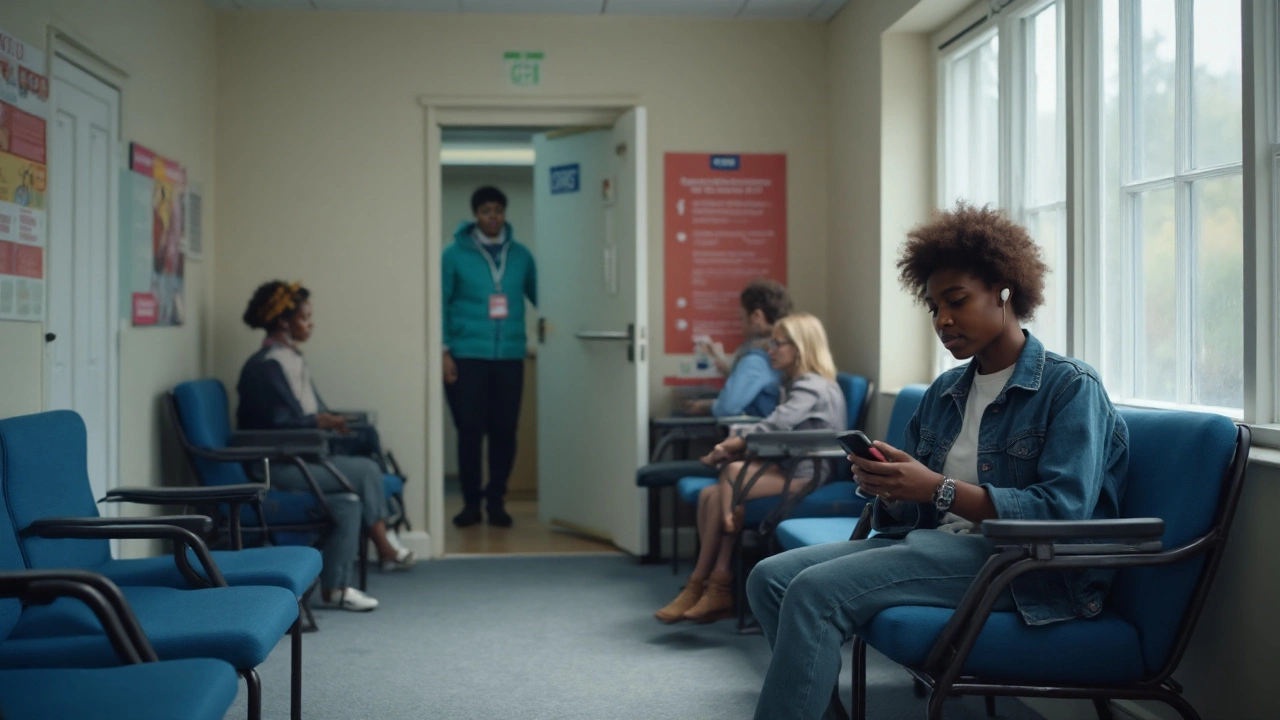 Sep, 5 2025
Sep, 5 2025
You tapped this because you want a straight answer: which symptom checker actually gets it right? Here’s the honest take. No app nails every case. Accuracy depends on the question you care about-“What might this be?” vs “Do I need care now?” Still, some tools consistently score better in independent tests, especially for safe triage. I’ll give you the best options for each job, how to use them without getting misled, and what to do next if the advice doesn’t match your gut.
TL;DR: The short answer
- There isn’t a single “winner” for every scenario. Apps tend to be better at triage (how urgent) than diagnosis (what condition).
- Across independent studies since 2015 (BMJ; BMJ Quality & Safety), average top diagnosis accuracy is modest, while triage safety is higher but still variable.
- If you want the strongest mix of condition suggestions + triage advice for everyday issues, Ada Health is often among the top performers in published vignette evaluations. WebMD is easy to use but typically scores lower on precision.
- For the safest urgency advice in the UK, NHS 111 Online is the most reliable first stop because it’s built for triage and plugs into local services. For the US, start with your insurer’s or health system’s nurse triage line if available.
- Best way to hedge: run two checkers, compare the overlap, and default to safety if they disagree. If you see red flags (new crushing chest pain, one-sided weakness, severe shortness of breath, blue lips, confusion, stiff neck with fever), seek urgent care-don’t wait on any app.
What “most accurate” really means, and who stands out in 2025
We throw around “accuracy,” but there are two different targets:
- Diagnosis accuracy (condition suggestions): Is the likely cause in the top 1-3 results?
- Triage accuracy (safety and appropriateness): Is the urgency advice right (self-care vs GP vs urgent care vs ER)?
The evidence base gives us a reality check:
- Semigran et al., BMJ (2015) tested 23 tools using clinical vignettes. Average top diagnosis correctness hovered around the mid-30% range; triage advice was appropriate about half the time, with wide variation. The big message: better at urgency than naming the exact disease.
- Ceney et al., BMJ Quality & Safety (2021) reviewed multiple studies and found performance varied a lot across tools and scenarios. Triage safety tended to be better than diagnostic accuracy, but both were inconsistent. Notably, pediatric and complex cases were tougher.
So what’s best today? As of 2025, a few patterns keep showing up across independent audits and large vignette studies:
- Ada Health: Often ranks near the top for condition suggestion while staying conservative on triage. It covers a broad range, asks detailed follow-ups, and supports kids and adults. Caveat: performance still depends on your exact case and how you answer.
- NHS 111 Online (UK): Built for triage, not diagnosis. If your main question is “Do I need help now?” it’s a safer first gate, and it routes you to local services.
- Symptomate (Infermedica): Solid triage logic and clear explanations; widely used behind the scenes by clinics and insurers.
- Isabel / VisualDx apps: Strong for clinicians and image-rich cases (rashes), with good differential lists-best if you want detail and are comfortable reading medical language.
- WebMD: Familiar and simple. Good for quick plausibility checks, but often less precise in studies.
What about generative AI like ChatGPT? Research in 2023-2024 showed LLMs can give helpful advice and sometimes strong triage, but they can also hallucinate and they’re not cleared as medical devices. Use them for education, not for deciding urgency or treatment.
Bottom line by job-to-be-done:
- “Tell me if this is urgent”: NHS 111 Online (UK) or your health system’s nurse line. If unavailable, Ada or Symptomate with a bias toward safety.
- “Give me likely causes to discuss with a clinician”: Ada, Isabel/VisualDx, Symptomate.
- “Skin/rashes”: VisualDx/Isabel image tools are strong; Ada also covers dermatology with structured questions.
- “Kids”: Use tools that support pediatric logic (Ada, NHS 111 Online). When in doubt with infants, call your clinician.
One last thing: even the most accurate symptom checker is a screening tool. It’s not a diagnosis. Think of it like a smart map, not the destination.

How to get the most reliable answer (and avoid the traps)
Small inputs make big differences. Here’s how to feed the algorithm good data and sanity-check the result.
- Pick the right tool for the job. Triage first? Use NHS 111 Online (UK) or your health plan’s triage nurse chat. Curious about likely causes? Use a high-quality checker like Ada or Symptomate.
- Set the scene correctly. Enter age, sex, pregnancy status, and key conditions. These change the math. A 60-year-old smoker with chest pain is not the same as a 22-year-old athlete.
- Describe symptoms with timing and triggers. Use concrete details: when it started, what makes it better/worse, highest fever number, exact location, new meds or travel, and one “odd” detail (e.g., pain wakes you at night).
- Don’t anchor on a self-diagnosis. Avoid leading answers like “it’s definitely reflux.” Let the questions guide you.
- Run a second checker. If two tools independently point to the same urgency level, you can trust that more. If they disagree, choose the safer advice.
- Read the triage wording carefully. “Contact GP today” vs “seek urgent care now” are not the same. If you’re unsure, err on urgent.
- Pressure-test with red flags. Compare your situation against red flag lists (below). Red flags trump any online result.
- Document and share. Save the output and bring it to your appointment. Clinicians like concise timelines and objective numbers.
Fast red-flag checklist (call emergency services or go to ER/ED if any apply):
- New crushing chest pain or chest pain with sweating, nausea, or breathlessness
- One-sided weakness, facial droop, trouble speaking, sudden severe headache
- Severe shortness of breath, blue lips or face, confusion, fainting
- Fever with stiff neck, rash that doesn’t blanch, or severe headache with light sensitivity
- Severe abdominal pain with guarding, vomiting blood, black stools
- Any infant under 3 months with a fever ≥38°C (100.4°F), poor feeding, or lethargy
Pro tips that move the needle:
- Use a thermometer and actual numbers. “High fever” means different things to different people.
- Measure heart rate and, if you can, oxygen saturation. Objective data improves triage.
- For rashes, note distribution (palms/soles? face? trunk?), texture, and any new drugs or exposures (hiking, pets, hot tub).
- If you have a chronic condition (diabetes, immune suppression), adjust your threshold for seeking care.
Examples, quick checklists, and a simple decision path
Examples help show how to think, not just what to click.
Case 1: 48-year-old with chest discomfort after dinner
- Details: Burning chest pain 2 hours after a heavy meal, worse when lying down, improved with antacids, no shortness of breath, can climb stairs fine.
- Likely outputs: Ada/Symptomate may list reflux/GERD high, with advice to contact GP if persistent or red flags appear. NHS 111 Online prioritizes ruling out urgent causes based on your answers; if no red flags, it may suggest primary care.
- What to do: Follow triage. If pain becomes crushing, radiates to the arm/jaw, or comes with breathlessness/sweats, treat as cardiac until proven otherwise.
Case 2: 2-year-old with fever and rash
- Details: Fever 38.9°C, red dots on trunk spreading to arms, playful between fevers, drinking fluids, vaccines up to date.
- Likely outputs: Pediatric-capable tools (Ada, NHS 111 Online) may suggest viral exanthem, monitor hydration, and GP if the rash worsens or new signs appear. If the rash doesn’t blanch or the child is lethargic or hard to wake, switch to urgent care immediately.
- What to do: Use a glass test for the rash, track fluids and diapers, and ring your clinician if anything changes.
Case 3: Hiker with calf pain and shortness of breath
- Details: 35-year-old, on a long-haul flight last week, now has calf tenderness and new breathlessness on stairs.
- Likely outputs: High-quality checkers may flag possible DVT/PE risk and direct urgent assessment. This is where triage accuracy matters more than a perfect label.
- What to do: Don’t wait. Urgent care or ED.
Quick personal checklist before you start:
- Write down: when it started, worst moment, what helps/hurts, all meds/supplements, and one “strange” detail.
- Measure: temperature, heart rate, and oxygen saturation if you have a pulse oximeter.
- Decide your guardrails: if the advice feels riskier than you can accept, choose the safer option.
Simple decision path you can actually use:
- Any red flag? Go urgent now.
- No red flag → Run a triage tool (NHS 111 Online in UK; otherwise Ada/Symptomate) → Follow the highest urgency suggested.
- Curious about causes? Run Ada or Isabel/VisualDx for a short list to discuss with your clinician.
- Worsening or new symptoms at any point? Escalate care, not app usage.

Side-by-side comparison, FAQs, and what to do next
Here’s a practical comparison focused on how you’ll actually use these tools in 2025. Evidence ranges reflect published evaluations (e.g., BMJ 2015; BMJ Quality & Safety 2021), vendor-independent audits, and typical user experience. Exact numbers vary by case mix and study design.
| Tool | Best for | Diagnosis suggestions | Triage safety | Coverage & notes | Price |
|---|---|---|---|---|---|
| Ada Health (app) | Balanced suggestions + triage | Often among top performers in independent vignette tests; still variable by case | Generally conservative; good at flagging urgent scenarios | Adults + pediatrics; broad condition set; detailed Q&A | Free app for consumers |
| NHS 111 Online (UK) | Urgency decisions and routing | Not designed for exhaustive differentials | Built for safe triage, with local service escalation | UK-focused pathways; clear next steps | Free |
| Symptomate (Infermedica) | Clear triage with explanations | Solid, with readable rationales | Conservative; good at “see a doctor” thresholds | Common in clinics/insurers; adult + some pediatrics | Usually free via partners |
| Isabel / VisualDx | Rich differentials; skin conditions | Strong for clinicians and informed users | Provides urgency cues but expects clinical judgment | Great images and diagnostic breadth | Consumer versions vary; pro tiers paid |
| WebMD | Simple, quick sense-check | Often less precise in studies | Basic triage; easy language | Very accessible; broad awareness | Free |
What the research means for you
- Expect triage to be safer than diagnosis. Studies like BMJ 2015 and reviews in BMJ Quality & Safety 2021 consistently show that naming the exact disease is harder than getting the urgency right.
- Performance depends on your case. Uncommon diseases, overlapping symptoms, and kids are tougher.
- Quality tools tend to ask more questions. If it feels like a quick horoscope, treat the output like one.
Mini‑FAQ
- Can any symptom checker diagnose me? No. These are decision-support tools. Only a clinician can diagnose.
- Is ChatGPT good enough? It can explain things well and sometimes gives sensible triage. It can also make confident mistakes. Use it for learning, not deciding urgency.
- Why do two tools give different answers? Different symptom databases, risk thresholds, and question flows. When in doubt, pick the more urgent advice.
- Are they safe for kids? Use pediatric-capable tools (Ada, NHS 111 Online). Infants under 3 months with fever need extra caution-call a clinician.
- Do these tools keep my data? Check each tool’s privacy policy. Prefer apps that store data locally or clearly explain how data is used and secured.
Next steps by scenario
- I need a fast urgency call: Use NHS 111 Online (UK) or your health plan’s nurse line. If not available, run Ada or Symptomate and follow the most cautious advice.
- I want a differential to discuss with my doctor: Use Ada, then cross-check with Isabel/VisualDx or Symptomate. Bring both outputs to your visit.
- I’m worried about a rash: Try a dermatology-focused tool (VisualDx/Isabel) with clear photos under good light. Note new meds, travel, and exposures.
- I have a chronic condition: Lower your threshold for in-person care. Note your meds and recent changes, and include them in the checker.
Troubleshooting if the advice feels off
- The app says “self-care,” but you feel worse: Escalate to urgent care or call emergency services if any red flag develops. Your body beats an algorithm.
- The suggestions don’t match your main symptom: Restart, enter age/sex/pregnancy, focus on the most prominent symptom, and add objective data (temp, HR).
- Two tools disagree on urgency: Choose the more urgent path. If safe to do so, call a nurse triage line to break the tie.
Credibility corner (why you can trust this guide)
- Findings align with independent research: Semigran et al., BMJ (2015) on early checker performance; Ceney et al., BMJ Quality & Safety (2021) systematic review on variable accuracy and triage safety.
- Public health guidance backs the red flags listed here (e.g., CDC emergency signs; pediatric caution from the American Academy of Pediatrics).
- We treat apps as tools, not oracles. We recommend safer defaults and real-world steps that clinicians actually use.
If you remember one thing, make it this: use a checker to get oriented, not to get clearance. If your symptoms are severe, new, or just feel wrong, see a human. Apps are the map. You are the driver.
